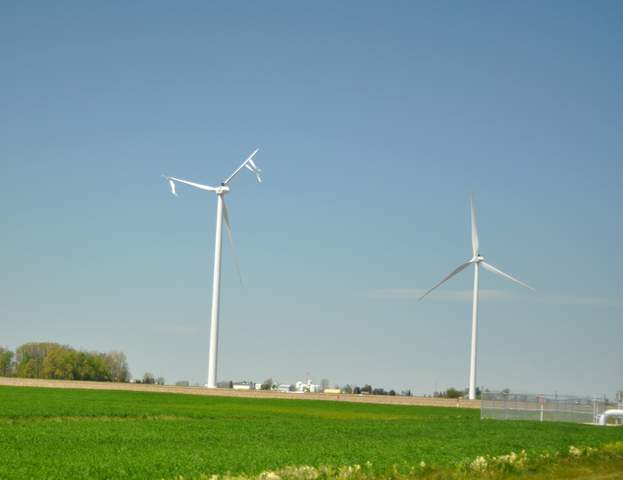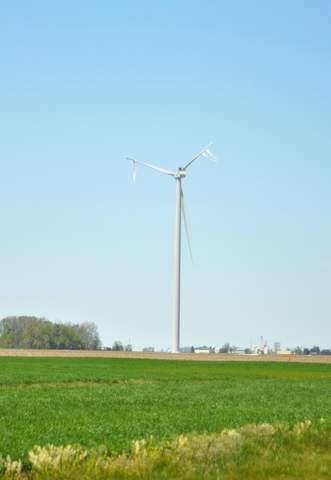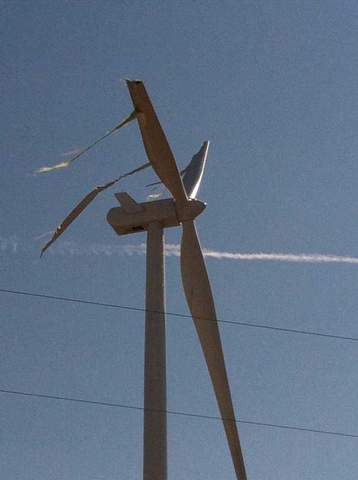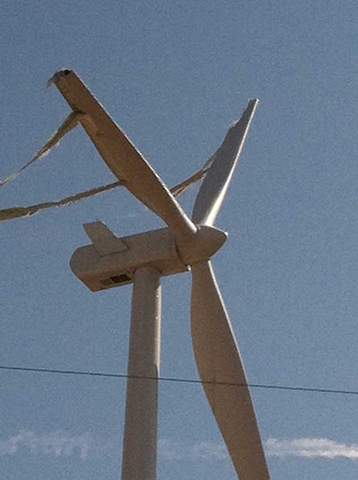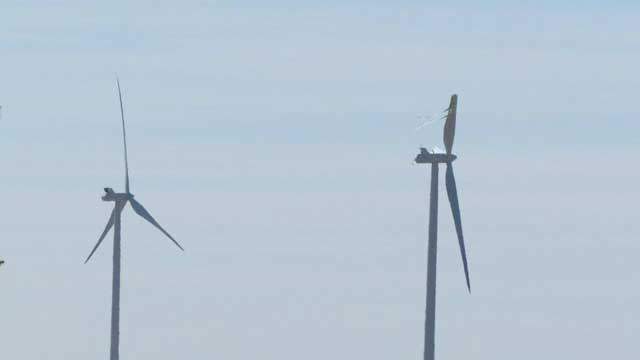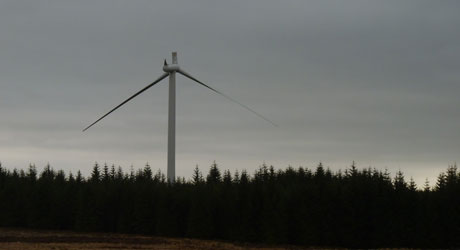Entries in wind farm accident (3)
4/25/12 Another one bites the dust AND Different state, same nightmare: wind developers pushing for 1000 foot setbacks from 500 foot turbines
MASSIVE WIND DAMAGE CAUSED BY WINDY CONDITIONS
Source WANE, www.wane.com
April 24 2012
A wind turbine in Paulding County, Ohio has been badly damaged.
According to a spokesman with EDP Renewables, the turbine, which is located near Payne, had two of its blades sheared early Tuesday afternoon.
Representatives from EDP Renewables have closed the site, which is known as Timber Road II and said no one was injured by the falling debris.
That particular turbine was completed in 2010 and is still under warranty by its manufacturer Vestas which is conducting their own investigation.
EDP is monitoring other turbines in the area for any signs of fatigue or damage.
NewsChannel 15 received several pictures a damaged turbine in Paulding County. We’ve added them to this story.
New York State
PUBLIC HEARING DRAWS FULL HOUSE
By Chris Hoffman,
Source: Madison County Courier, www.madisoncountycourier.com
April 25, 2012
The crowd at the Public Hearing before the Town of Madison Planning Board nearly filled the 350-seat auditorium at Madison Central School on April 18. The hearing opened at 7 p.m. and more than 40 local residents read comments until almost 10:30 p.m.
Comments were overwhelmingly opposed to the project, with only 7 in favor, most of whom were members of the Stone Family who live near the existing windmills on Stone Road and who stated they have experienced no adverse affects. Several speakers subsequently pointed out, however, that comparing the two projects is meaningless because of the difference in size, scope, and siting.
The proposed wind farm would site 36 turbines within and around a residential area that contains over 150 homes, with each turbine nearly 500 feet tall and within setbacks of 1,000 feet from existing homes. Additionally, the proposed turbines are a new model with no track record, as they have never been used anywhere in the country.
Speakers represented a broad demographic spectrum – people who have lived here since they were young children; people who relocated here to get away from industrialization and overcrowding; fourth generation farmers and new farmers; business owners with past experience in the energy and construction industries; homeowners who have lived here for decades and built or bought their homes because of the proximity to a serene natural environment.
Many speakers addressed specific sections of the draft Generic Environmental Statement (dGEIS) submitted to the Planning Board for review, pointing out numerous flaws and inadequacies. Jane Welsh stated that the Planning Board should never have accepted the dGEIS for review because it is incomplete as it stands, and should have been returned to the developer for corrections.
Laura Wilson of Hamilton Village Real Estate and Sue Martin of Martin Realty both spoke to the “blatant inadequacy” of the section in the dGEIS concerning real property values, which sites a 2009 report that states, “neither the view of the wind facilities nor the distance of the home to those facilities is found to have any consistent, measurable, and statistically significant effect on home sales prices.” Both Wilson and Martin, who have more than 50 years of combined experience in the local real estate market, cited studies and data that refuted this conclusion, and termed the report relied on by the dGEIS as fatally flawed and outdated.
Bob Albrecht spoke of childhood memories of growing up on Thayer Road, where he and his brother Carl used to play in the woods among the trees, trees that he has always referred to as the “Witness Trees,” because they have been there so long that they bear witness to the generations of families who live in this area, noting that “individuals have a reasonable expectation to the quiet enjoyment of their homes.”
Eve Ann Shwartz spoke on behalf of the Hamilton Town Council.
“The Hamilton Town Council believes that the proposed project would violate Town of Hamilton laws adopted to protect our citizens from the negative impact of improperly planned windpower projects,” Shwartz said. “With the currently proposed siting, Hamilton properties bordering on the Madison town line may be subject to quality of life impingements and health concerns such as flicker effect and noise pollution. The Town of Madison’s current regulations and buffers are not as protective as those provided under the Town of Hamilton’s zoning.”
“While we understand that the Town of Madison’s laws control the development of land in Madison, we believe that the siting of wind farms is a unique type of land use,” she added. “Because wind turbines can be seen for many miles and the noise they generate and the shadows they create can extend for thousands of feet, their impacts can extend beyond town boundaries. We respectfully request that you honor the intent of our laws and modify the siting of the proposed project.”
Shwartz also addressed the potential impact on property values.
“The proposed project is sited within one mile of 92 properties in the Town of Hamilton, covering 1,807 acres with an assessed value of $8,716,400,” Shwartz said. “According to numerous studies, wind turbine projects have a negative impact on nearby property values. A recent study of more than 11,000 property transactions in Franklin, Clinton, and Lewis Counties found an average reduction in value of 7-15 percent for properties located within one mile of wind turbine projects. Owners of these 92 properties will experience a collective loss of value ranging from $610,148 to $1,307,460. The Town of Hamilton will likewise see its tax base eroded by the same amounts, resulting in lower property tax and sales tax revenues.”
Shwartz requested that the Town of Madison demand larger setbacks from properties located within the Town of Hamilton.
Additionally, Shwartz requested that any PILOT payments going to the Town of Madison be shared proportionally with the Town of Hamilton, “to reflect that portion of our town residents with impacted viewscapes, and that the PILOTS be increased to $7,500/MW in order to compensate Town of Hamilton taxpayers for the loss of property values.”
Town of Madison Supervisor Ron Bono stepped up to the microphone about midway through the evening. The room went silent, waiting to hear what Bono would say. He said, “After taking the trip to Hardscrabble Wind Farm in Fairfield last Sunday, and seeing windmills in every direction, I now want to see the size and number of these proposed windmills reduced, as I do not want to change the landscape of Madison.” The crowd erupted in applause.
The Town of Madison Planning Board will continue to accept written comments on the dGEIS until 5 pm on Friday, May 18. Written comments will be given the same consideration as oral comments made at the public hearing, and may be submitted by mail (certified mail is recommended) to the Town of Madison Planning Board, P. O. Box 66, Madison, NY 13402. After the comment period ends on May 18, the Planning Board has 30 days to review all comments.
The dGEIS is available online at http://madisonmatters.org/dgeis/, where it has been divided into individual chapters and appendices for easier viewing.
Chris Hoffman is a freelance reporter for the Madison County Courier.
5/15/10 DOUBLE FEATURE: If a 130 foot long turbine blade falls into DeKalb county field and and no one knows why, does it matter? AND Reach out and touch your PSC: They want your comments on the new draft siting rules which look like the old siting rules.
 NOTE FROM THE BPWI RESEARCH NERD: Last week DeKalb county IL was the latest location for yet another "unusual" wind turbine failure resulting in a 131 long blade breaking off for the usual reason: That is: no one knows why it happened. The turbines have been in operation for five months.
NOTE FROM THE BPWI RESEARCH NERD: Last week DeKalb county IL was the latest location for yet another "unusual" wind turbine failure resulting in a 131 long blade breaking off for the usual reason: That is: no one knows why it happened. The turbines have been in operation for five months.


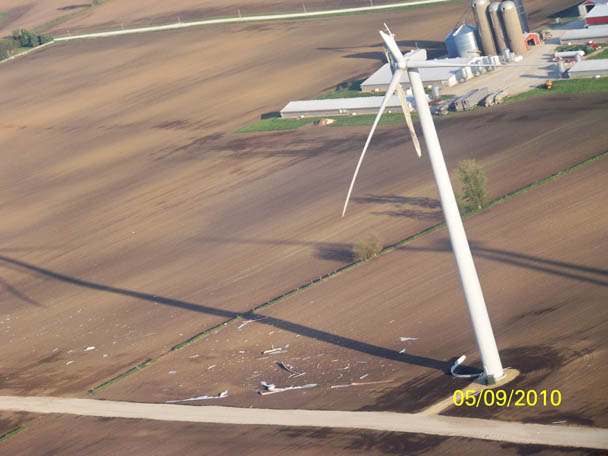
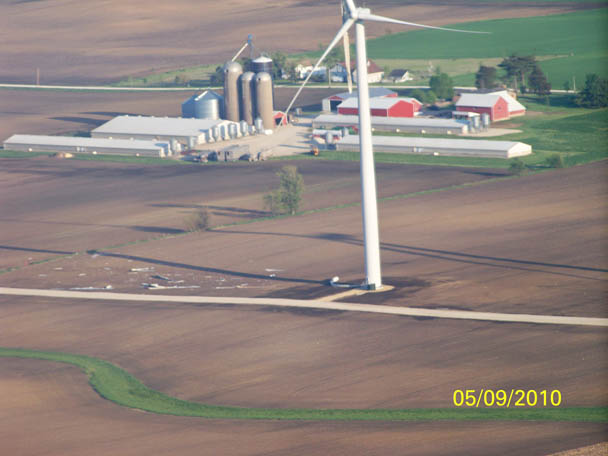
CLICK HERE to read a daily log about one family's life in this wind project
READ THE FULL NEWS STORY BY CLICKING HERE: www.daily-chronicle.com
Turbine Blade Damage 'Unusual"
May 7, 2010
By Dana Herra
SHABBONA TOWNSHIP – Officials at NextEra Energy Resources aren’t sure what caused one of the three blades on a wind turbine south of the village of Shabbona to fail Friday morning. The 131-foot-long blade hung from the top of the turbine Friday, apparently bent at the base and split along its length.
That type of failure is unusual, NextEra spokesman Steve Stengel said.
“Our inspection at this point has just been visual, so at this point we don’t know what caused that,” Stengel said Friday afternoon. “Based on just visual inspection, it’s very unusual to have a blade fail and look like that.”
Stengel said the blade failed about 7:30 a.m. Friday.
SECOND FEATURE:
Public Service Commission seeks public comment on proposed wind siting rules.
wispolitics.com 14 May 2010
MADISON – The Public Service Commission of Wisconsin (PSC) is seeking public comment on the proposed wind siting rules, issued today by the PSC. The proposed rules will ultimately result in uniform wind siting standards for local units of government in Wisconsin and ensure consistent local procedures for regulation of wind energy systems.
“Developing uniform wind siting standards is crucial for a sound energy future in Wisconsin,” said Chairperson Eric Callisto. “I look forward to receiving robust public input on these proposed rules and finalizing them later this summer.”
2009 Wisconsin Act 40 (Act 40) requires the PSC to promulgate a variety of rules that specify the conditions a city, village, town, or county (political subdivision) may impose on the installation or use of a wind energy system. If a political subdivision chooses to regulate such systems, its ordinances may not be more restrictive than the PSC’s rules. The PSC will also consider the restrictions specified in these rules when determining whether to grant a certificate of public convenience and necessity for a wind energy system over 100 megawatts.
The PSC established docket 1-AC-231 to conduct the rulemaking under Act 40. Act 40 requires the PSC to conduct this rulemaking with the advice of the Wind Siting Council. The Wind Siting Council is an advisory body created by Act 40. The Wind Siting Council members have begun to provide input to Commission staff concerning these rules during a series of meetings in early 2010. The PSC will seek comments from the Wind Siting Council on the proposed draft rules issued by the Commission.
Any person may submit written comments on these proposed rules. Comments on the proposed rules will be accepted until July 7, 2010, at noon (July 6, 2010, at noon, if filed by fax). The comments are considered when staff is drafting the rules. The PSC will hold hearings to take testimony from the public regarding the proposed rules in the Amnicon Falls Hearing Room at the Public Service Commission Building, 610 North Whitney Way, Madison, Wisconsin, on June 30, 2010. Act 40 requires that hearings regarding these rules also be held in Monroe County and a county other than Dane or Monroe, where developers have proposed wind energy systems. The PSC will also hold public hearings on these proposed rules at City Hall, Legislative Chambers, 160 West Macy Street in Fond du Lac on June 28, 2010, and Holiday Inn, 1017 East McCoy Boulevard in Tomah on June 29, 2010.
More information on the Wind Siting Council and the wind siting rulemaking pursuant to Act 40 can be found by visiting the Commission’s website and clicking on the Electronic Regulatory Filing System (ERF) at http://psc.wi.gov/. Type case numbers 1-AC-231 in the boxes provided on the ERF system. To comment on the proposed rules, click on the Public Comments button on the PSC’s homepage and scroll down to select Wind Siting Rulemaking.
Contact: Teresa Weidemann-Smith, (608) 266-9600
3/23/10 TRIPLE FEATURE: What made the 150 blade snap off the turbine? AND What they are saying in DeKalb County, IL AND On the subject of Wind Turbine Syndrome, the doctor is IN
Wind farm shut down over safety fears after 150 ft turbine blade falls off
SOURCE: The Daily Record, www.dailyrecord.co.uk
March 23, 2010
Exclusive by Ben Spencer
Europe’s largest wind farm ground to a halt after a 150ft blade snapped off one of the turbines.
All 140 of the giant machines were immediately shut down at the £300million development near Glasgow until they could be inspected.
Engineers at Whitelee wind farm, which is run by ScottishPower Renewables, were trying to work out why the blade came crashing down.
They are looking into whether lightning could have struck the turbine or if it was caused by a mechanical problem.
It sheared off and hit the ground in the early hours of Friday morning in blustery conditions.
Automatic systems alerted operators in the control room to the damage and they immediately closed down the unit.
All 420 blades in the wind farm were being examined following the accident.
Last night, more than 50 turbines were expected to have been inspected and safely returned to operation.
The process is expected to be completed by Friday.
Whitelee wind farm’s visitor centre, which is managed by Glasgow Science Centre and had been due to reopen after the winter break yesterday, stayed shut.
German company Siemens, who supplied the turbines, are also understood to be investigating.
The 360ft turbines are so massive that engineers have been able to climb inside them to try to detect the problem.
Over the weekend, the site at Eaglesham Moor, 13 miles from Glasgow city centre, was cordoned off to keep visitors away. Raymond Toms, 45, a teacher from East Kilbride, spotted the broken turbine as he cycled past on Sunday.
He said: “I was out for a bike ride and I saw one of the massive blades had broken clean off. It was quite unnerving really.
“You can walk right up to these things normally and touch them.
“The public have access to the network of pathways nearby.
“I have grave concerns over the safety of the public, who can walk right up to the turbines.
“It’s worrying that if one of these could fall off then perhaps another one could.
“It’s made me think about going too close, that’s for sure. It’s just lucky this took place at night, when nobody was around.”
Keith Anderson, managing director of ScottishPower Renewables, said: “This type of incident is exceptionally rare and highly unusual.
“However, the safety of our people and the public is our first priority.
“While the investigation into the cause of the incident is ongoing, our engineers continue to conduct an internal and external examination of all turbine blades at the wind farm”.
A spokesman for the firm added: “Investigations are ongoing, and a number of possibilities including mechanical failure and lightning strike are being considered.
“Operators in the 24-hour control room immediately closed the turbine down.
“This is a highly unusual situation. I’ve not heard of this kind of incident happening in 30 years.”
GREEN ENERGY BLUEPRINT
Whitelee was officially switched on in May 2009 by First Minister Alex Salmond.
Each turbine at Whitelee, which started producing electricity in January 2008, stands 360ft high.
The wind farm has 140 turbines that can generate 322 megawatts of electricity, enough to power 180,000 homes.
ScottishPower Renewables have been given permission to add 36 turbines to the site, allowing the wind farm to power 250,000 homes and create up to 300 jobs.
Last week, it was revealed that community groups in East Renfrewshire are to benefit from a fund set up from the development of Whitelee.
The fund will deliver about £140,000 a year for the next 25 years to the area’s council for local groups.
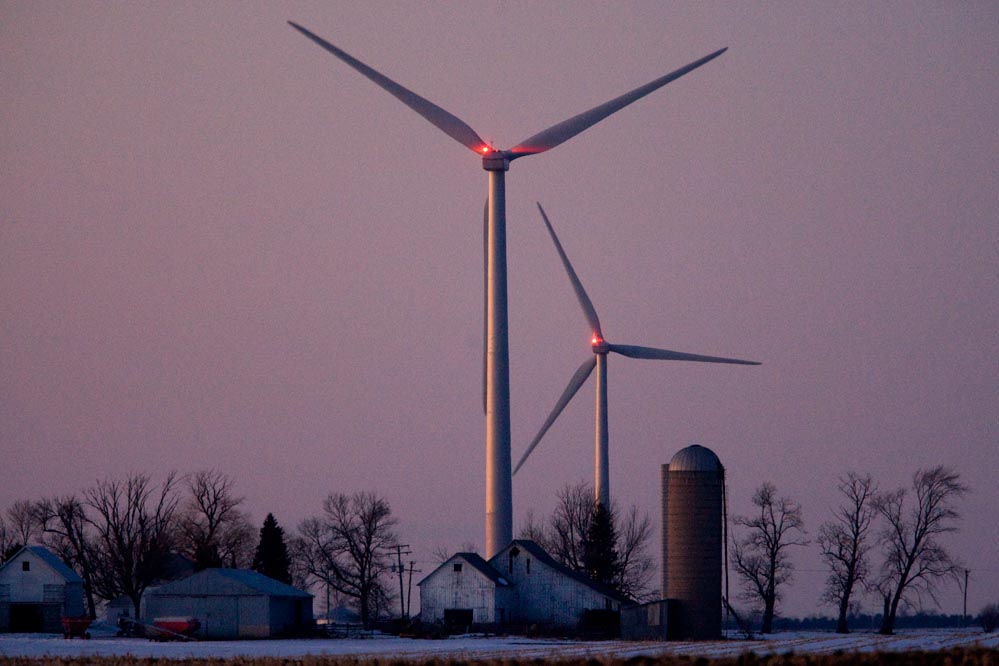
SOURCE: A Photo Blog :: Chicago Photojournalist Alex Garcia
Most people when asked are in favor of wind energy. Green. No foreign oil. No spent fuel rods. Cool-looking turbines.
But when a reporter and I went out to DeKalb County to talk to residents embroiled in a lawsuit surrounding a wind farm installed in an otherwise tranquil setting, we heard quite an earful.
Residents pitted against each other, noise, shadow flicker, lost sleep, stress, dead animals, lower real estate values, lost sightlines. It was a long list of complaints.
Although many people wrote off their grievances as little more than NIMBY, you do have to wonder whether 1400 feet is the sufficient amount of distance that a turbine should be from the foundation of a home.
Landowners who allowed the wind turbines on their properties are to be paid $9000 a year, per turbine, for the privilege. Some had a few. In this economy, I can see it from their perspective too. In this case, however you look at it, the wind blew up a storm.
SECOND FEATURE:
Letter from Dr. Nina Pierpont against siting wind turbines near home
SOURCE: Wind Concerns, Ontario
I am told that wind developers are proposing to build industrial-scale wind turbines as close as 270 meters [less than 900 feet] from people’s homes.
This is a reckless and violent act. The evidence for turbines producing substantial low frequency noise and, worse, infrasound, is no longer in dispute.
The clinical evidence is unambiguous that low frequency noise and infrasound profoundly disturb the body’s organs of balance, motion, and position sense.
The case studies performed by me and other medical doctors have demonstrated unequivocally that people living within 2 km of turbines are made seriously ill, often to the point of abandoning their homes.
There is no doubt among otolaryngologists and neuro-otologists who have studied the evidence that wind turbine low frequency noise and infrasound are seriously disrupting the body’s vestibular organs, resulting in the constellation of illness I have called Wind Turbine Syndrome.
The cure for Wind Turbine Syndrome is simple: Move away from the turbines or shut off the turbines.
The prevention of Wind Turbine Syndrome is even simpler: Don’t build these low frequency/infrasound-generating machines within 2 km of people’s homes.
Governments and corporations who violate this principle are guilty of gross clinical harm. Such governments and corporations should be taken before whatever level of court is necessary to stop this outrage.
I realize these are strong words. They are carefully chosen. They are strong because governments and the wind industry stubbornly—I would add, criminally—refuse to acknowledge that they are deliberately and aggressively harming people. This must stop. The evidence is overwhelming. I repeat, this must stop.
Nina Pierpont, MD, PhD
Fellow of the American Academy of Pediatrics
Former Clinical Assistant Professor of Pediatrics, College of Physicians & Surgeons, Columbia University, New York
